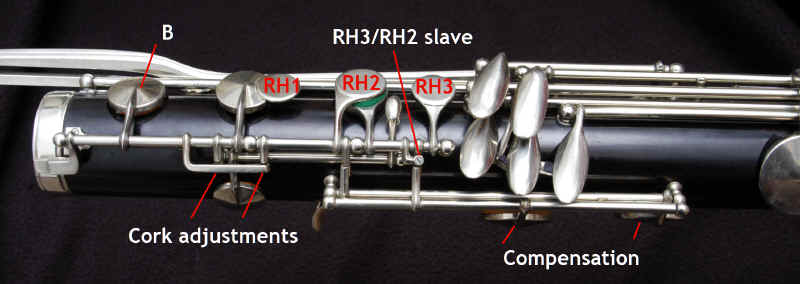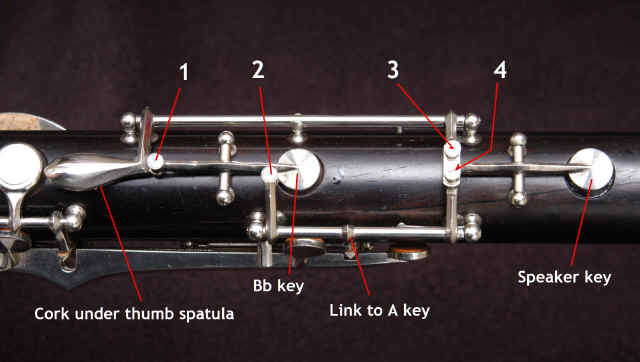
These pages are my effort at explaining how speaker mechanisms work. The proper adjustment is more than important, it is ABSOLUTELY VITAL or the instrument may not produce a single note! On the other hand, understanding how it works is a long way towards keeping it all working as it should. (I do not pretend that these notes are exhaustive, but I do hope they are useful. If I have got something wrong please tell me so others aren’t led up the same gum tree.)
I have not mentioned problems due to bent rods or damaged springs or pads. I assume that the horn is in basic working order.
Before any adjustments are attempted, be clear what the problem is. It
will probably be something like;
If it still plays stuffy or hard, there is a leak; honestly! There IS a leak!
There are lots more things that can cause problems, usually seeming to be out of proportion to the size of the defect.

Screws 1 & 3 balance the speaker key action when closed (not
depressed), so that both keys are fully closed.
There must be play in the link to the A key at screws 2 & 4 when this
adjustment is made.
Screw 2 adjusts Bb key to be closed when speaker key is pressed and A key is NOT pressed.
Screw 4 adjusts amount of opening of speaker key when speaker spatula is pressed and A key is NOT pressed.
Also limits opening of Bb key when A key IS pressed at the same time as the speaker spatula.
Further, it ensures that speaker key is closed whenever A key is fully open.
Cork thickness under speaker spatula adjusts how much opening is available to both keys without lost motion. A key bumper cork is also involved. (see below).
There may be one or more adjusting screws in the linkage to the A key, which take up lost motion.
When there is a link to the right hand keys so that the Bb key operates as a speaker key for mid staff B, C, D and maybe E, this must be DISCONNECTED until the left hand mechanism has been adjusted to work properly. Only then may it be brought into play. It duplicates the action of the left hand A key linkage and is the least important action. (but still desirable).
** Bb key and speaker key are shut when no key is pressed. (screws 1 & 3)
** Bb key stays shut when the A key is pressed and the speaker spatula is NOT pressed. (screw 1)
** speaker key stays shut when the A key is pressed and the speaker spatula is NOT pressed. (screw 3)
** speaker key opens when the A key is NOT pressed and the speaker spatula IS pressed. (screw 4)
** Bb key stays shut when the A key is NOT pressed and the speaker spatula IS pressed. (screw 2)
Try to ensure that Bb key is fully open and speaker key is fully closed just as the A key bumper cork hits the body. (A key and speaker spatula bumper corks).
Any linkage to right hand keys operates to duplicate the A key linkage action and operates fully ONLY when the RH key is fully pressed. (otherwise a spongy action results)
So, the procedure is;
If the speaker key opens too much, high B, C (above staff) may be sharp. (open usually about 1 to 2 mm). Adding a RH finger may be preferable to reducing the speaker venting.
If the Bb key opens too much, mid Bb may be sharp, but more usually is stuffy if not open enough. (open usually about 3 to 5 mm).
When there is a link to the right hand keys the Bb key operates as a speaker key for mid staff B, C, D and maybe E. If the Bb opens too little, B, C, D (E) may be stuffy; also too open a Bb ‘speaker’ may degrade B, C, D, (E) timbre.
(References to ‘another hand’ may involve a second person!)
Play the pinched Bb (middle of staff) and hold speaker key closed with another hand. If there is no change, all is well – the speaker key closes OK.
Compare Bb (above) with side Bb. If no difference then the Bb key opens enough. If it’s stuffy, open some more by reducing cork bumper under speaker key spatula, or opening screw 4.
Play mid staff C and B (all fingers down) to check pitch and timbre. If it is suspected that there is a problem not opening enough, temporarily loosen 3 and 4 so that the speaker key can open more and try it. Ease the speaker spatula closed to test the effect of closer action. (Or use another hand) Closer action sometimes improves the timbre as well as affecting tonality but is tricky to adjust for. Water is more troublesome with closer action. Remember to re-adjust 3 & 4.
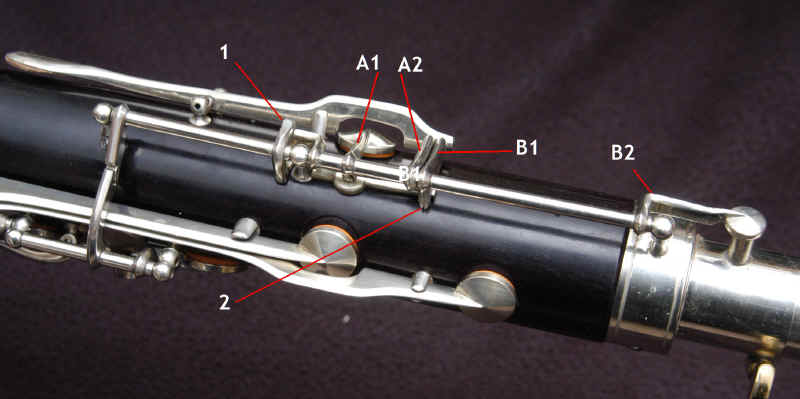
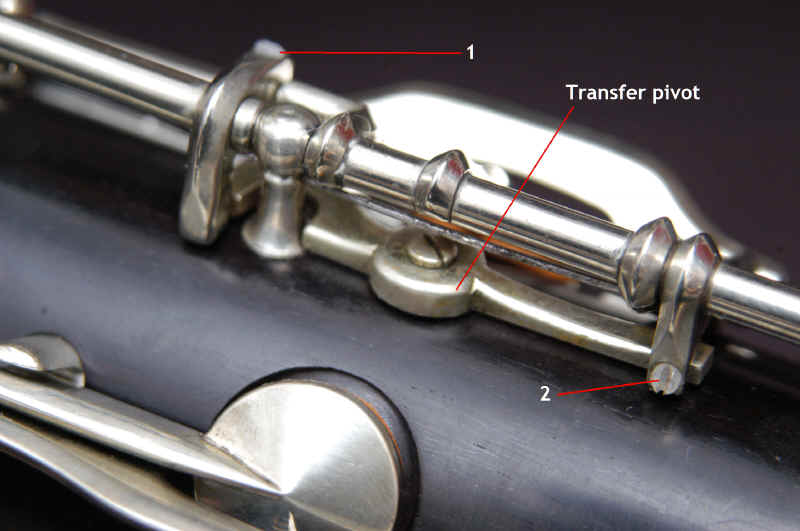
Leblanc bass speaker mechanism and close up of transfer linkage.
Speaker key action when closed (not depressed),is to ensure that both keys are fully closed. This is achieved by bending the Bb lever (A1) relative to Bb key arm (A2), and the speaker key lever (B1) relative to the speaker key arm (B2), so that the speaker lever end presses on each lever equally and at the same time! This is easier to do than explain and is more effective and reliable in practise than you might expect. The Selmer balance arm addition makes a more elegant mechanism.
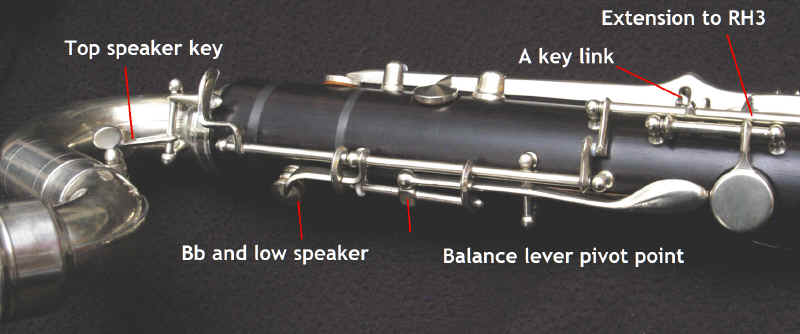
There must be play in the screws 1 & 2 when this adjustment is made.
Screw 1 ensures that Bb key is closed whenever A key is NOT open.
Screw 2 ensures that speaker key is closed whenever A key IS fully open.
Cork thickness under speaker spatula adjusts how much opening is available to both keys without lost motion..
There may be one or more adjusting screws in the linkage to the A key, which take up lost motion.
When there is a link to the right hand keys so that the Bb key operates as a speaker key for mid staff B, C, D and maybe E, this must be DISCONNECTED until the left hand mechanism has been adjusted to work properly. Only then may it be brought into play. It duplicates the action of the left hand A key linkage and is the least important action. (but still desirable).
Old Selmer basses had a link to thr RH3 key only ensuring that mid staff B, C, D used the Bb hole as the speaker, and only E upwards used the top speaker hole.
** Bb key and speaker key are shut when no key is pressed. (lever angles A1/A2, B1/B2 – see above)
** Bb key stays shut when the A key is pressed and the speaker spatula is NOT pressed. (as previous)
** speaker key stays shut when the A key is pressed and the speaker spatula is NOT pressed. (as previous)
** speaker key opens when the A key is NOT pressed and the speaker spatula IS pressed. (screw 1)
** Bb key stays shut when the A key is NOT pressed and the speaker spatula IS pressed. (screw 2)
Try to ensure that Bb key is fully open and speaker key is fully closed just as the A key bumper cork hits the body. (A key and speaker spatula bumper corks).
Any linkage to right hand keys operates to duplicate the A key linkage action and operates fully ONLY when the RH key is fully pressed. (otherwise a spongy action results)
So, the procedure is;
If the slot in a nylon screw is destroyed, make a piece of soft wire into a screwdriver shape that is just small enough to go into the grub screw hole. Heat the tip of it to dull red (this is why you don’t use your screwdriver!) and melt a new slot into the screw (easiest when the screw is screwed in below the hole level.) Pull the hot wire out while still hot so it doesn’t stick.
On my clarinets;
The thread size of the hole is 8BA which is 59 tpi x 0.086” dia.
The thread size of the screw is American 2-56 which is 56 tpi x 0.086” dia.
The difference in thread pitch just tightens the screw a bit to help it stay as adjusted but I lock screws with ‘Copydex’ (latex).
(The real reason was that I could get 8BA taps but not 8BA screws; or 2-56 screws but not 2-56 taps!)
All, some or none of these screws may be present. In all cases the intended use is to adjust the slave keypad to close at exactly the same time as the operating keypad. NEVER use these screws to remove lost motion – that is taken out by adjusting bumper corks.
Sometimes screws are fitted simply to adjust key height and thus tonality or timbre. This is the case with any screw adjusting the C key which can also control the key height of the D and E keys in the upper stack.
In the right hand, any adjusting screws are to make coincident closing of the B slave pad. If there are no screws adjustments are made by corking or key bending.
Oddballs like the old Selmer bass, P-M bass, Buffet alto etc., may have compensation systems using extra holes or combinations of holes to improve response in some way. Figuring out why some of these systems were developed is a fascinating exercise which has the advantage of being pretty near unprovable!

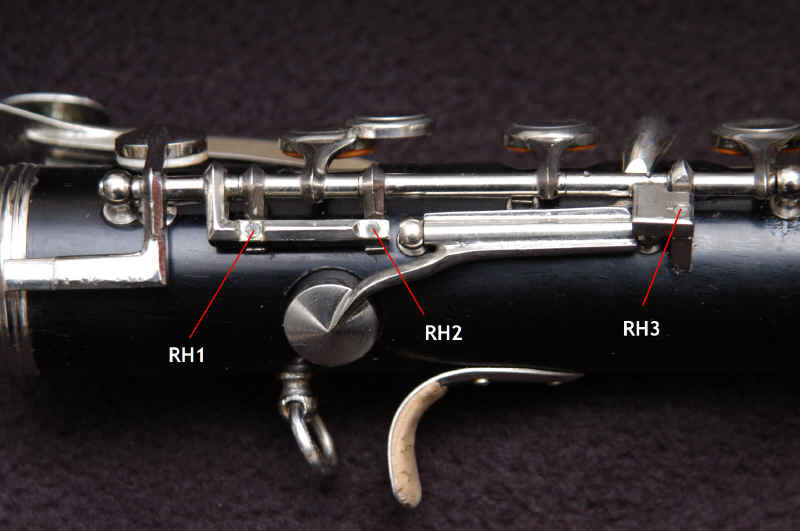
‘H’ refers to possible places to put key height adjusters.
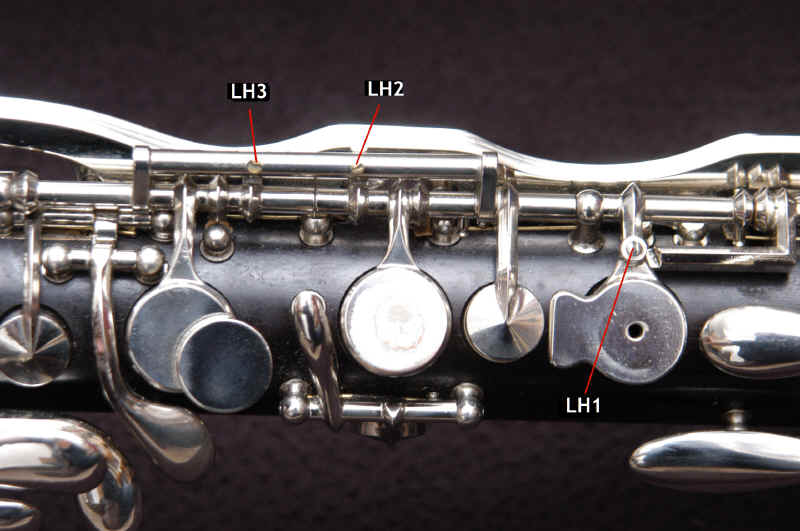
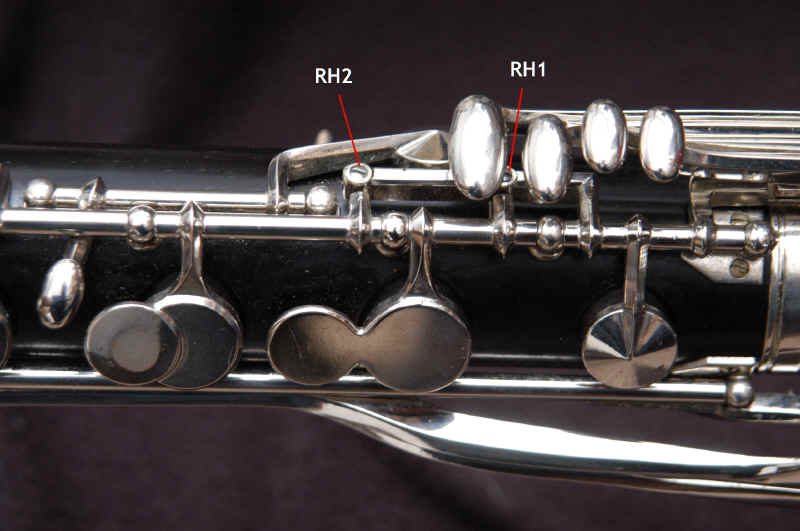
All screws adjust co-incidence.
